
Table of Contents
Scientific Classification
- Kingdom: Animalia
- Phylum: Chordata
- Class: Amphibia
- Order: Anura
- Family: Hylidae
- Genus: Agalychnis
- Species: Various species within the Agalychnis genus
Quick Overview
The Red-Eyed Tree Frog, belonging to the Hylidae family and Agalychnis genus, is an iconic amphibian renowned for its vibrant colors and distinctive appearance. Native to the tropical rainforests of Central America, including parts of Mexico, Costa Rica, Panama, and Nicaragua, these frogs have become a symbol of the rich biodiversity of their habitats.
Fast Facts
- Scientific Name: Various species within the Agalychnis genus
- Lifespan: 5 to 8 years in the wild, potentially longer in captivity
- Average Size: Approximately 2 to 3 inches
- Diet: Insectivorous, feeding on small insects and other invertebrates
- Habitat: Tropical rainforests, residing in vegetation near water sources
- Conservation Status: Least Concern
Did you know?
The vibrant red eyes of the Red-Eyed Tree Frog serve a dual purpose – intimidating predators when the frog sleeps during the day and assisting in capturing prey in low-light conditions.
Appearance
Red-Eyed Tree Frogs are known for their striking colors. They have vibrant green bodies with blue and yellow markings, a vibrant orange underbelly, and large red eyes. This coloration not only aids in camouflage among the rainforest foliage but also acts as a warning to potential predators.
Size and Weight
These tree frogs are relatively small, with adults typically reaching sizes of 2 to 3 inches. Their slender bodies and large, webbed feet are adaptations for life in the trees.
Temperament and Behavior
Primarily nocturnal, Red-Eyed Tree Frogs are arboreal creatures, spending their days perched on leaves and branches. They are well adapted to a life in the trees, possessing sticky toe pads for climbing. Despite their bright colors, they are masters of camouflage, blending seamlessly with their surroundings.
Fun Fact
Red-Eyed Tree Frogs have a distinctive “foot flagging” behavior, where they wave their brightly colored feet, possibly to startle predators or communicate with other frogs.
Habitat and Distribution
These frogs inhabit the lush tropical rainforests of Central America, favoring areas near ponds, streams, and other water sources. Their distribution spans regions from southern Mexico to Panama.

Care Guide
In captivity, providing a vertical terrarium with ample foliage, branches, and a water source is crucial. Maintaining appropriate temperature and humidity levels, along with a diet of small, gut-loaded insects, contributes to their well-being.
Diet and Nutrition
Red-Eyed Tree Frogs are insectivores, preying on small insects and invertebrates. A varied diet that includes appropriately sized crickets, flies, and other live insects is essential for their health.
Health and Wellness
Regularly monitoring the environmental conditions, including humidity and temperature, is vital for the health of captive Red-Eyed Tree Frogs. Regular veterinary check-ups are advisable to address any health concerns.
Reproduction
Breeding usually involves laying eggs on leaves above water. Upon hatching, tadpoles fall into the water, where they undergo metamorphosis into froglets. The vibrant coloration develops as they mature.
Conservation Status
Red-Eyed Tree Frogs are currently classified as Least Concern by the International Union for Conservation of Nature (IUCN). However, habitat loss and fragmentation pose potential threats to their populations.
Fun Fact
The toes of Red-Eyed Tree Frogs are equipped with adhesive discs, enabling them to grip onto leaves and branches, showcasing their remarkable climbing abilities.
Photo Gallery
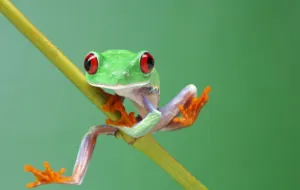
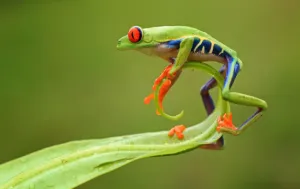
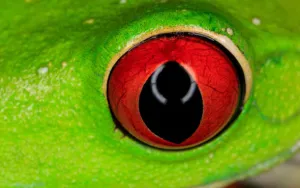
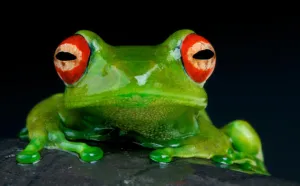
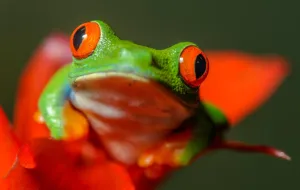
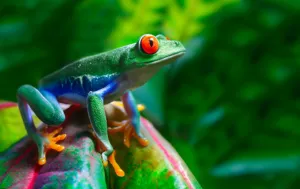
Related Profiles
Share This Profile
3 Fascinating Facts About Red-Eyed Tree Frogs
- Camouflage Masters: Despite their bright colors, Red-Eyed Tree Frogs are expert camouflagers, blending seamlessly with the lush foliage of tropical rainforests.
- Nighttime Symphony: Male Red-Eyed Tree Frogs are known for their distinct vocalizations, contributing to the vibrant nighttime chorus of tropical rainforests.
- Dynamic Coloration: The vibrant hues of Red-Eyed Tree Frogs are not only eye-catching but also serve as a form of communication, signaling their health and readiness to potential mates.
- Enchi Ball Python: A Unique and Stunning Morph of Python regius - March 27, 2025
- Emerald Tree Monitor: The Enigmatic Green Guardian of the Rainforest - March 26, 2025
- The Egyptian Cobra (Naja haje): A Fascinating Serpent - March 25, 2025
